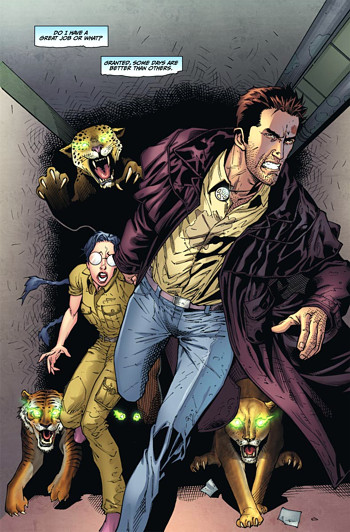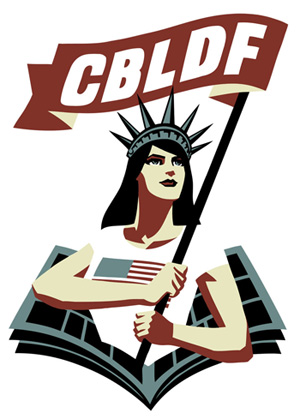 |
 |
Review by Mark Worthen |
|

Writer: Jim Butcher Artists: Ardian Syaf Del Rey / Dabel Brothers $19.95 US ISBN: 0-34550746-0 |
|||
Medium. Mode of transmission. Method of delivery. The way you hear or read or see a story.
Nowadays, our most beloved stories and most memorable characters come at us in several different ways. Superman, for example, and cop hero Joe Friday have been heard on the radio, seen on television and in movies, found in comic books (yes, there was a short-lived Dragnet comic, not to mention newspaper strip) and read about in books. If a character is engaging enough to accrete a following, he or she will appear in more and more formats. Superman appeared in Action Comics, then quickly got his own title. He then moved to the small screen (in at least three different live-action and at least four different animated formats), the large screen, video games, and toys and games. Much the same happened with Joe Friday and his series of partners in Dragnet.
The same is particularly true of beloved urban wizard Harry Dresden. He appeared and became well-followed in Jim Butcher's Dresden Files series, which begins with Storm Front. Harry is the only practicing wizard listed in the Chicago yellow pages ("No love potions"). He is part of the White Council, the ruling group of wizards who keep the world safe from paranormal threats and practitioners of questionable magic.
 The aptly-named Welcome to the Jungle is a prequel to the Dresden Files, occurring before the events of the series begin. It is clearly not Harry's first adventure in Chicago, as he is already established as consultant to Special Investigations, the branch of Chicago P.D. that looks into the strange and the supernatural. If Second City's police had an X-files, S.I. would be it. He's acquaintances, if not friends, with Karrin Murphy, the head of S.I., and we see that he's already acquired Bob, the spirit of intellect who resides in a human skull. Other characters, both new and familiar, move across the stage during Harry’s quest for information.
The aptly-named Welcome to the Jungle is a prequel to the Dresden Files, occurring before the events of the series begin. It is clearly not Harry's first adventure in Chicago, as he is already established as consultant to Special Investigations, the branch of Chicago P.D. that looks into the strange and the supernatural. If Second City's police had an X-files, S.I. would be it. He's acquaintances, if not friends, with Karrin Murphy, the head of S.I., and we see that he's already acquired Bob, the spirit of intellect who resides in a human skull. Other characters, both new and familiar, move across the stage during Harry’s quest for information.
For quest it is, since S.I. has once again hired his assistance to find out who murdered a security guard at a local zoo. All leads point to the gorilla in a nearby cage. One who could not have opened his cage to murder the guard and would not have returned there and relocked it had he been able to do so. As he goes from zoo employee to zoo employee asking questions, he receives nothing for his trouble except an assault with cold coffee. Finally, he questions the gorilla keeper, Reese, who offers him a beer. Harry's response? "Doc, you and I are going to get along just fine."
The book is a compilation of four original issues, originally intended as a lead-in to the release of the Dresden Files books in comic title form. That’s right, all of the books, beginning with Storm Front and continuing on, have been and will be released in comic form as long as the public keeps buying. I found several pristine issues in a bargain bin just last week while looking for something else. I snapped them up, of course.
One problem with seeing characters one is already familiar with in a new medium such as film or graphic novel, is that the actors chosen to portray those people or the artist's rendering of them is frequently not what the viewer or reader might have chosen. This, for me, is true of Welcome to the Jungle. But since Butcher himself wrote the script, which would have included penciling instructions, the artist is more faithful to the descriptions of them as he might have been otherwise. Except that it seemed to me Murphy always wore her hair in a pony tail, which she does not in this GN. Oh well. A search for picky consistency is for the small-minded, as someone said, right?
Still, the art is excellent.
Pencils are done by Ardian Syaf, who lives in Indonesia, and his work seems part of a certain noir style becoming more and more popular. I first noticed it in the work of artists like Mike Dringenberg and Steve Dillon who sometimes use a starker, darker style of line-drawing and shadowing, existing in that twilight zone between Frank Miller and Jack Kirby's late-60s work. I like it – just as it lent itself to Constantine’s dark world, for example, it lends itself well to Harry's fantastic Chicago as well.
I should probably issue a caveat if you decide to get this book: It is not Butcher's best work by any means. Dead Beat and Death Mask, for example, far exceed this book in both plot and readability. Butcher also puts good work into his fantasy series, the Codex Alera. But Jungle is a good solid unpredictable story which keeps the reader turning pages. Newcomers to Dresden will like this and fans will love it.
The hardcover is still in print, but the paperback is not and is getting harder and harder to find. If you're a Dresden fan, your collection won’t be complete without Welcome to the Jungle. You'll want to own it and put it chronologically in front of the books. If you're not a Dresden fan, let me take this opportunity to let you know: you might be before you're finished with this one. The Harry Dresden character and Butcher's easy narrative style are that addictive. I apportion myself a Dresden Files book every eight months or so; that way I always have a new one to read.
Fair warning.
Three fanboys, only because some of the Dresden books are so much better.



This review copyright 2009 E.C.McMullen Jr.
| CHANGE YOUR SHIRT | |
| FEO AMANTE'S HORROR THRILLER Created by: E.C.MULLEN JR. |
| COME FOLLOW ME @ Amazon |
| ECMJr |
| Feo Blog |
| IMDb |
| Stage32 |
| YouTube |
| Zazzle Shop |


